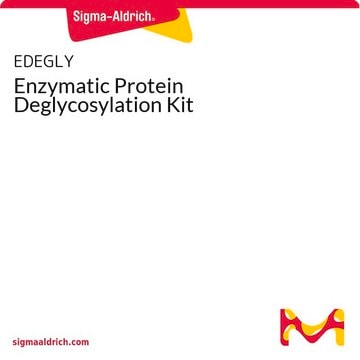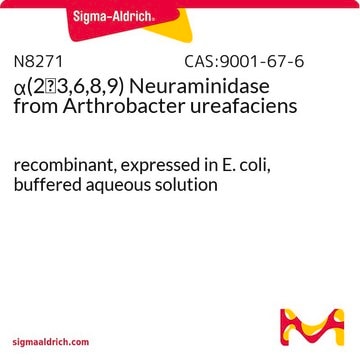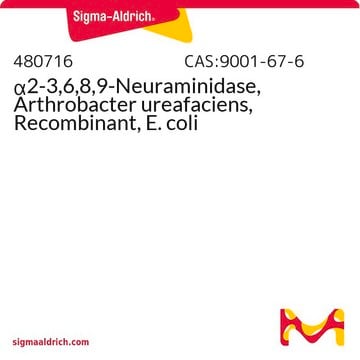This assay is intended to be conducted in a cuvette. There is no specific guidance supplied for this protocol to be used in a multi-well plate format. Please see the link below to review the full Technical Bulletin:
https://www.sigmaaldrich.com/deepweb/assets/sigmaaldrich/product/documents/228/218/sialicqbul.pdf
推荐产品
运输
wet ice
储存温度
2-8°C
一般描述
应用
数量
仅试剂盒组分
- N-Acetylneuraminic acid aldolase 25 μL
- N-Acetylneuraminic acid 200 μL
- α(2→3,6,8,9)-Neuraminidase 25 μL
- Fetuin, bovine .5 mg
- Lactic dehydrogenase 25 μL
- β-NADH disodium salt 3 vial(s)
- Tris-HCl, pH 7.5 1 mL
- Sialidase buffer 500 μL
储存分类代码
10 - Combustible liquids
其他客户在看
商品
Understand sialic acid structure, function, signaling, and modifications. Easily find products for sialic acid research.
Understand sialic acid structure, function, signaling, and modifications. Easily find products for sialic acid research.
Understand sialic acid structure, function, signaling, and modifications. Easily find products for sialic acid research.
Understand sialic acid structure, function, signaling, and modifications. Easily find products for sialic acid research.
-
How does the size of the multiwell plate affect the volumes of reagents used, and how is the final calculation of nmoles of NANA adjusted accordingly?
1 answer-
Helpful?
-
-
How should a time course experiment be conducted to assess if digestion has reached completion? Can NANA on a glycoprotein be measured in multiple samples simultaneously using a multiwell plate as detailed in section 2, "Assay of Multiple Samples for Free NANA," or is this method only applicable to free NANA?
1 answer-
1.This kit utilizes α(2→3,6,8,9) neuraminidase to cleave all NANA linkages, including α(2→8) and α(2→9) linkages, as well as branched NANA. To determine when the digestion is complete, measurements of free NANA released at different times can be taken and plotted on a graph to illustrate the change in NANA concentration over time. The endpoint of digestion is identified as the point where no further increase in product concentration is observed, allowing for accurate determination of the time required to completely digest all the NANA in a sample.
2. For a time course experiment, one may start with an immediate baseline reading and continue with readings at 1, 2, and 3 hours to monitor the release of NANA. If the released NANA levels off between the 3 to 5-hour marks, the reaction is complete. For complex samples or high NANA concentrations, extending the incubation time points beyond 5 hours, and checking hourly, may be necessary. The optimal incubation time and/or the sample quantity would need to be adjusted based on preliminary findings to ensure complete digestion without degradation.
3.Adapting this protocol for a multiwell plate involves performing the enzymatic digestion as described in the procedure for the target sample type (e.g., free NANA, glycoproteins, or polysialic acid). After the digestion step, one would follow the steps outlined in the "2. Assay of Multiple Samples for Free NANA" section. Adjustments to the volume may be needed based on the well size of the multiwell plate. For example, for a 100 μL well, the volumes of the reagents would need to be adapted proportionally, and the final calculation of nmoles of NANA should reflect the smaller reaction volume.Helpful?
-
Active Filters
我们的科学家团队拥有各种研究领域经验,包括生命科学、材料科学、化学合成、色谱、分析及许多其他领域.
联系技术服务部门











